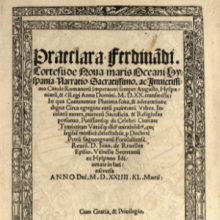Browse Primary Sources
Locate primary sources, including images, objects, media, and texts. Annotations by scholars contextualize sources.

Brooklyn's Panorama Competition
The Panorama is one of the biggest events for steel bands in Brooklyn. Originating in Trinidad, it is tied to the Carnival season and is best understood as a music competition embedded in a series of festive activities and performances.

Neolithic Bone Flutes
The use of musical instruments, such as clay flutes and bone whistles, has been traced back to the earliest documented historical period in China (Shang dynasty, 1765-1121 BCE).

Javanese Gamelan
Here, a Javanese gamelan (court orchestra) performs at a traditional wedding ceremony in Indonesia. A gamelan relies on intricate music played on expensive, exquisite bronze instruments to convey their community's values, ideals, and self-image. What the gamelan performs depends on context. In a private, intimate court setting, the gamelan displays the elegance and largesse of its patrons.

Shiva as the Lord of Dance
This manifestation of the Hindu god Shiva depicts the deity holding a small drum, which symbolizes the audible space that fills the universe, the sound of creative energy. Here, rhythm, drum, and music are manifestations of fundamental Hindu beliefs. At concerts of Indian music, audiences listen to drummers raptly and follow their complex rhythms in cycles.

Huun-Huur-Tu Throat Singers
Huun-Huur-Tu is a musical group from Tuva, which is situated along the Mongolia-Russia border, that is known for their traditional throat singing. Throat singing is when performers sing both a note and its overtones simultaneously, resulting in a rich and complex timbre, or the sound quality and texture of instruments and voices performing the music.

Javanese Shadow Puppets
Music and dramatized storytelling are the tools of memory in places like the Indonesian island of Java. Here, a traditional Wayang, or Javanese, performance depicts Hindu epics or popular cultural legends through the use of leather puppets whose shadow is cast upon a thin fabric. Traditionally, the performance is backed by a Gamelan orchestra and usually lasts all night.

The Griots of West Africa
Music has served as a language of memory in many cultures around the world. In West Africa, a Griot, or Jali, is part of a special, hereditary caste of individuals charged with knowing and retelling the stories and histories of the local people.

Wagner's Ride of the Valkyrie
Although it is important to take into account an artist's intentions and hopes for new music, it is equally important to realize that music is often appropriated - meaning that it is used by others in ways that the artist did not intend. Take for example Richard Wagner's famous musical drama The Valkyrie.

Silent Film Sheet Music
Music permeates cultures around the world. From movies, sporting events, funerals, weddings, and religious services, it is hard to imagine life without music in the background. Take, for example, this sheet music from the early twentieth century.

Tree Rings as Climate Archive
World historians who study environmental history sometimes sometimes seek out atypical sources to conduct their research.

X-ray of a cross-section of a coral core
World historians who study environmental history sometimes sometimes seek out atypical sources to conduct their research.
The Constitution of the Iroquois Nations
This text is the first seven of 117 clauses of the Constitution of the Iroquois Nation. The Iroquois Constitution, also known as the Great Law of Peace, is a written transcription of collected oral histories and traditions that documents the formation of the Haudenosaunee (the Iroquois Confederacy).
Pedro de Cieza de Léon: Chronicles of the Incas, 1540
This text is an excerpt from Spanish conquistador Pedro de Cieza de Léon's writings on the Inca and Peru. He served as a solider during campaigns in present-day Colombia and Peru. He participated in the reconquest of Peru from Spanish rebel forces. After the reconquest, he interviewed local officials and Inca lords about Inca history and culture.

Mesoamerican Pictogram
Between 1541 and 1542 Antonio de Mendoza, viceroy of New Spain, commissioned a Mesoamerican Codex containing text and Aztec pictograms. This image is one example.

Hernán Cortés: Second Letter to Emperor Charles V, 1520
This text is an excerpt of a letter sent from Spanish conquistador Hernán Cortés to the Spanish King, Charles V, in 1520. This letter is one of several extended letters sent by Cortés to Charles V detailing the conquistador's expeditions in present-day Mexico and his campaigns against the Mexica (Aztecs).
Horace, “Cleopatra Ode”
Given Horace’s position in Emperor Augustus’ court, it is not surprising that his description of Cleopatra is wholly negative. This text relies on “sourcing” and an understanding of the author’s bias and motivation for a proper reading. He describes Cleopatra as a “deadly monster” although he does, at least, admit to her bravery in submitting to the venom of the serpent.
Antony’s Meeting with Cleopatra from “Life of Antony”
Cleopatra’s claim to the Egyptian throne very much resided in her relationship and alliance with Caesar. Upon his death in the Senate, Cleopatra had lost her guarantor. Antony’s arrival in Egypt provided a second opportunity for her to secure her throne through a powerful alliance.
Cleopatra’s Meeting with Caesar
Cassius Dio’s history of the meeting between Cleopatra and Julius Caesar uses powerful word-choice to develop a characterization of the female Egyptian ruler. After Pompey’s assassination, Cleopatra immediately develops a scheme to ally with Caesar. Dio uses words like “beauty,” “striking,” and “charming” to describe her and explains that she had the “power to subjugate” anyone.
Advice to Bride and Groom (versus 14 and 18)
Plutarch’s Advice to a Bride and Groom reveals the author’s views that submissiveness is the proper behavior for a Roman patrician’s wife, which reflects the general gender norm of ancient Roman culture. The wife ought to mimic the husband’s mood at all times: to be happy when he is happy and serious when he is serious.
Aristotle’s Metaphysics
Metaphysics, written around 350 BCE, is among Greek philosohper Aristotle's most notable works. The text includes an excerpt from part seven of the ten part work.